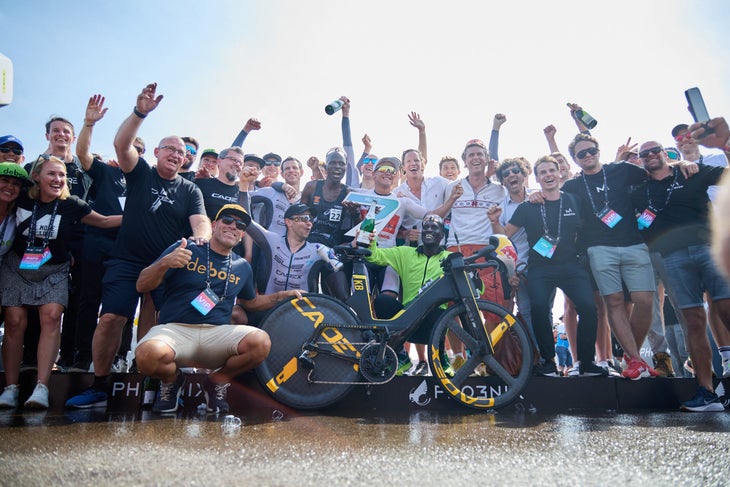Commentary: Yes, Iron-Distance ‘Records’ Were Broken, But Was Sub7/8 A Success?
While it's easy to criticize the spectacle of Sub7/Sub8, says Tim Heming, who was on the ground in Germany, there's so much more to appreciate in it.
New perk! Get after it with local recommendations just for you. Discover nearby events, routes out your door, and hidden gems when you sign up for the Local Running Drop.
So, they did it. They all did it. And—with the smell of burning rubber on tarmac still filling the nostrils—they did it with gusto.
In fact, from the moment the trains of riders headed away from the shores of Lake Senftenberg, tailwind pushing them on towards the track near Dresden, there seemed little doubt that all four triathletes would utterly obliterate the target times that were set.
Sub7? Sub8? Pah! This was a challenge billed as trying to “defy the impossible.” What it really was—and was probably always going to be—was an exercise in proving exactly what is possible over the iron-distance when you lift a few constraints.
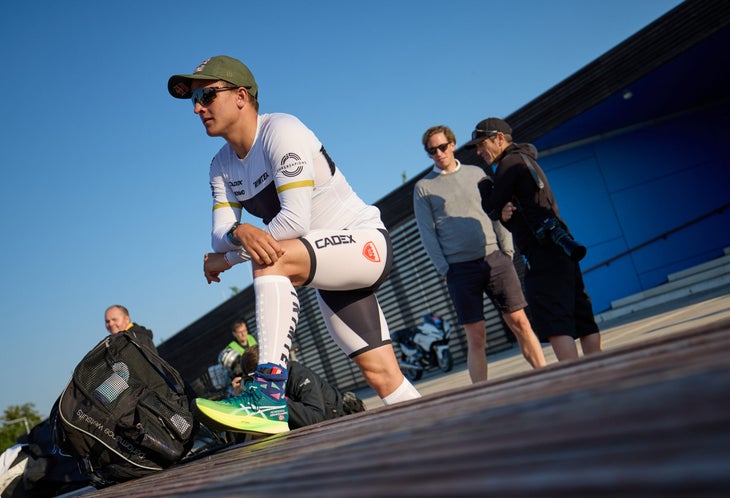
And for all the talk of the huge draft effect, curated courses, and an army of support athletes, when Joe Skipper’s time-trialing aces are hauling him to a 3:16 bike split for 112 miles and Kat Matthews is stopping the clock at 7:31, I’d wager what’s possible is a damn sight more than most of us predicted.
Despite all the preamble hype—and let’s be honest, Sub7 and Sub8 are little more than nice round numbers—no one really had a clue where the limit of possibility lay, and thus what was actually being defied. (Except perhaps soothsayer Skipper, who came within seconds with his 6-hour 47-minute prediction.)
It has always been very easy to snipe at the Pho3nix Foundation Sub7/Sub8 challenge as a bastardization of the sport, a confected irrelevance that sullies the true spirit of solo long-course racing, and no more so than when comparisons to “world record” times are drawn.
That’s all fine, if a little tiresome, but I also bet most naysayers cast at least half-an-eye over yesterday’s proceedings, just to see it anyway. If there’s one thing two-time Ironman world champion and organizer Chris McCormack does well it’s get eye balls on triathlon, innovate, push boundaries, create a stir. Use whatever phrase you like.
But if your sole purpose is denigration of this one-off experiment in Germany, then you might just miss some of the subplots, because there was plenty here to enthrall.
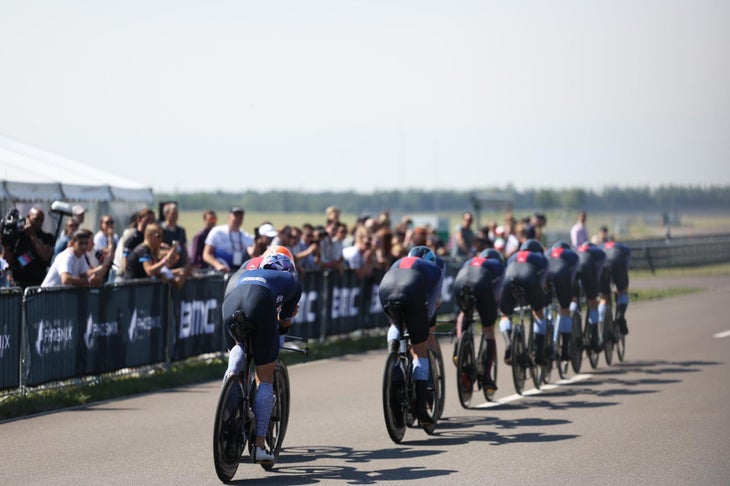
First, and perhaps most of all, it was a spotlight on the strength of characters we have in this wonderful sport. Two of the participants, Matthews and Skipper, were late replacements due to injury to Lucy Charles-Barclay and Alistair Brownlee. Carbon-plated or not, those are some big triathlon shoes to fill—particularly, as in Skipper’s case, when you have less than a week’s notice to do so.
That they chose to step up at all is a mark of their character, and while I don’t have the exact figures to hand, I can assure you there are easier ways to make a buck—even in triathlon.
Then there was 40-year-old Nicola Spirig, in her final year, recovering from a bike crash in February that left her with a broken collarbone, broken ribs and a punctured lung. Spirig, essentially, just being Spirig.
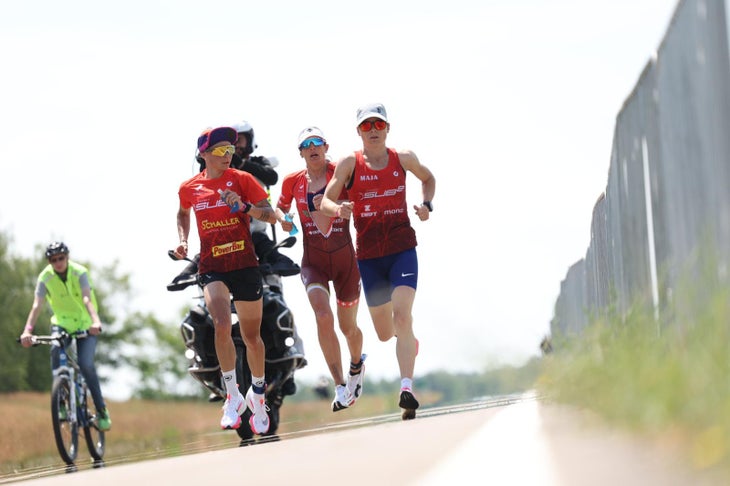
Finally, Kristian Blummenfelt, the now Olympic, Ironman, and World Triathlon champion, and the first triathlete ever to cover the distance in under 7 hours (6:44:25 to be precise) all in the space of 10 months.
Take in the splits. Take in Spirig’s mastery of paceline riding on a road bike. Take in Matthews’ epic re-passing of her on the marathon, or Skipper’s will to hold Big Blu at bay until the second half of the run. Take it all in. And while we had two winners, really we had four. Not just in the way they all beat the chosen standard, but in how they applied themselves to the challenge.
Then again, we could also say there was a 40-strong cast behind them—and those were just the ones in neoprene, lycra, and running singlets. The team element was another standout aspect of Sub7/Sub8 that just doesn’t happen elsewhere in triathlon.
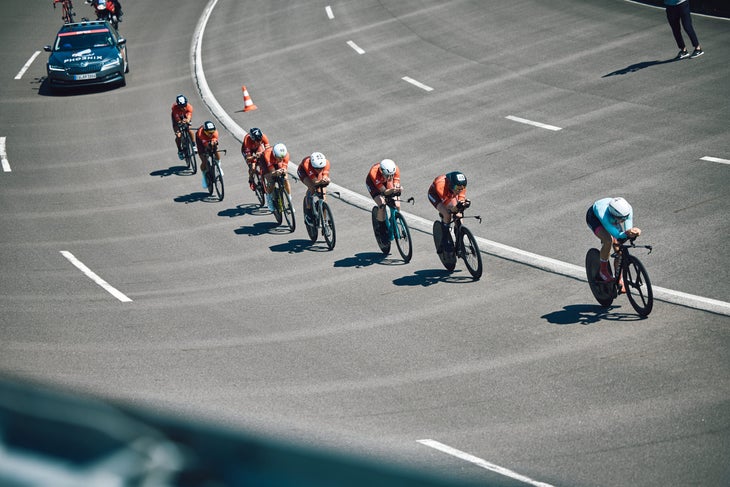
The pinpoint preparation for the team time trial, the tinkering in the garages so every prototype piece was tuned in—yes, including that controversial top-tube-less CADEX prototype bike the silky smoothness of the changeovers on the track, post-ride huddles in the pit lane, and celebrations down the finish chute and long into the night. It was triathlon meets Formula One meets Grand Tour TT-ing. It was just different. And blistering times aside, it was refreshing.
It also had McCormack already spinning with future ideas, including introducing more teams and making the spectacle bigger. Quite whether that works remains to be seen. A lap of the Dekra Lausitzring test track was 3.6 miles with banked turns at either end—and the speed they were moving made it seem like half that. With team cars and camera bikes, things could get very busy, very quickly.
Yet from the position of adding additional elements and bringing new eyes to the sport, it makes a lot of sense. The team time trial aspect and optimizing it free from UCI rules—Team Skipper 3D-printed the equivalent of rear bottle cages and added them behind each saddle to aid air flow—is something we haven’t seen in triathlon since Ironman Barcelona.
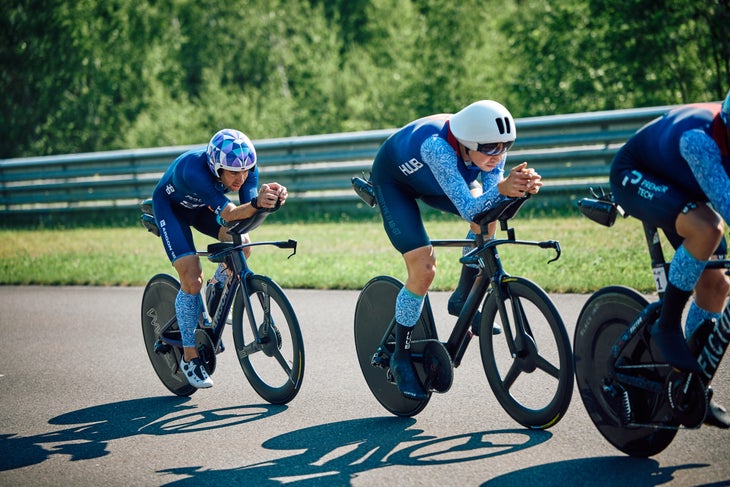
Alex Dowsett of professional cycling team Israel-Premier Tech, who has been riding professionally since 2010 and flew into Germany straight from the Giro d’Italia, said it “was one of the best things I’ve ever done on a push bike” and “the most epic team time trial I’ve ever been part of.”
If Dowsett is convinced and his ilk become intrigued, then the wider cycling audience and sponsors start to care too. That has to be good for triathlon.
We can argue the same—although admittedly to a lesser extent—for the run and swim. As Skipper would probably attest, you could have had Michael Phelps in there with him, but he wasn’t catching Blummenfelt in the water. An aside, but for all the lack of talk about how the swim might affect this attempt, ultimately it probably cost Skipper the win.
(The Ironman Barcelona comment was a joke by the way. Sort of.)
Elsewhere, Sub7/Sub8 was just a playground for innovation and creative thinking, from the intricately engineered to the wacky left-field play. From chunky 8mm thick wetsuits, aero vests worn under regular trisuits, to Skipper’s cycling outrider carrying a tank of chilled water and a spray gun to cool him down throughout the run, very little was off-limits.

There were the last minute scrambles too that meant problem-solving was a priority: riders flying in the night before, Skipper’s trisuit from sponsors DHB being turned around so quickly they stitched a reminder of the exact time into the material. Plus, blue-and-red Vuvuzelas handed out to honk at him through the run.
There were also sighs of relief. COVID, poor weather, or a touch of wheels could all have ruined the day. Other than one close squeak for Team Blummenfelt and controlling a 34mph speed wobble, it went off without a hitch.
The broadcast, so much-maligned in this sport, ticked up a notch yet again too. With the Professional Triathletes Organization, Super League Triathlon, World Triathlon, Ironman, and Challenge all trying to a greater or lesser degree, there is a constant impetus to improve right now—and Sub7/Sub8 got the big calls right.
Of course, it helps the budgets were there. To keep a helicopter and drones in the air for eight hours doesn’t come cheap. Nor does shutting down a motor racing test circuit for a week. But they also got the format and mix of personnel right. As anchor Will McCloy said: “There were only four triathletes. We had to be prepared to make an event look dramatic when the entire race might not have had a single pass!” To that end it was a commendable job. The baton has now passed to the PTO for its PTO Tour this summer.
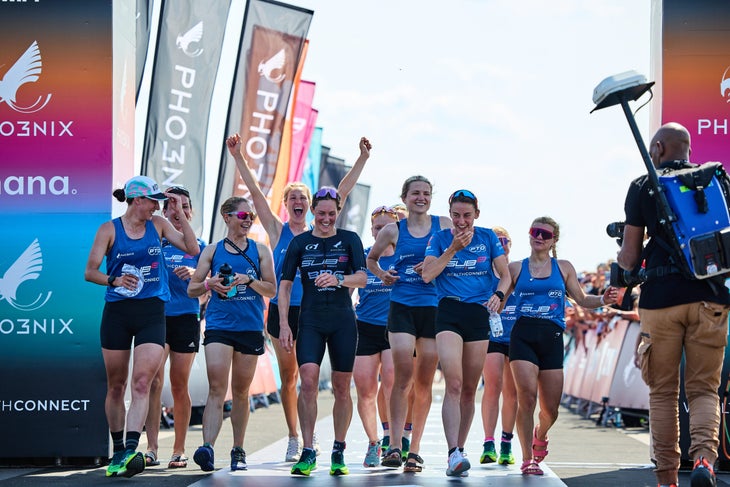
Has the impossible been defied? A benchmark has certainly been set, but whether this event will be replicated in the future remains less certain. Sub-6:30 and Sub-7:30 doesn’t quite have the same ring—and had Matthews been a couple of minutes faster that one would have already been answered.
Perhaps expect something a bit broader from the Pho3nix Foundation first. After all, set up in 2020 as a nonprofit organization to promote the importance of exercise to children through sport, its remit extends far beyond tri.
“We have a hundred crazy ideas,” said founder Sebastian Kulczyk. “All I’ll say is that there are 20-30 million kids in Africa who don’t have sports shoes. We really should do something about that!”
Bringing it back to Sub7/Sub8 for now, though. “I’m super happy. Every crazy event has its critics, but every one of us can define our own goals in life. If an individual’s goal is to break Sub 7 or Sub 8, great. If it’s simply to get off the couch, that’s great too. I’m not judging. That’s the easy bit. It’s more difficult to do.” In Dresden, like it or not, they certainly did it.
